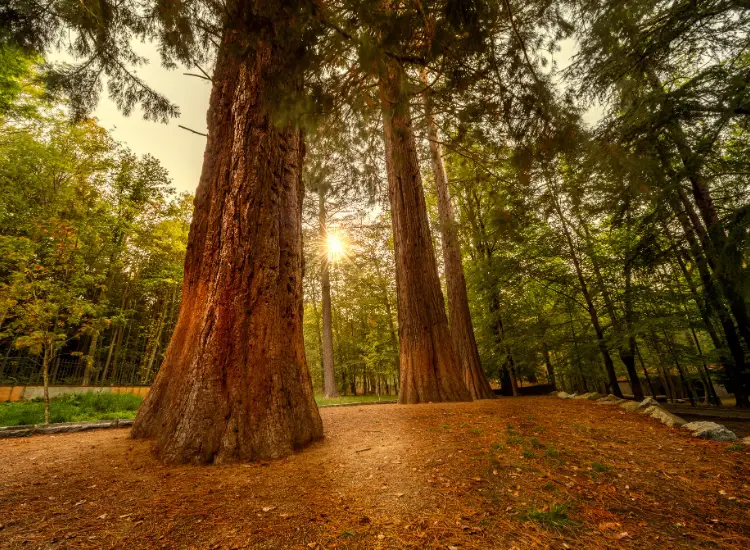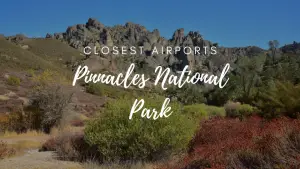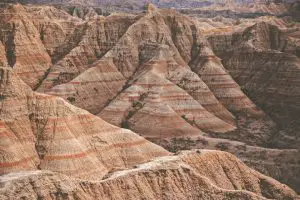Where to See Sequoia Trees? (And What To Expect)

Are you wondering where to see sequoia trees? These magnificent giants are some of the tallest and oldest trees in the world, and they can be found in specific locations that provide the perfect environment for their growth. If you’re a nature enthusiast or simply fascinated by these impressive trees, you’ll want to know where to go to witness their grandeur.
In this article, we’ll explore the best places to see sequoia trees, from the famous Sequoia National Park in California to lesser-known locations that offer unique opportunities to appreciate these natural wonders. Whether you’re planning a vacation or simply want to learn more about these majestic trees, keep reading to discover the top destinations for experiencing the awe-inspiring beauty of sequoias.
Quick Links
National Parks with Sequoia Trees
- Sequoia National Park: Located in California, this park is home to the largest trees in the world, including the famous General Sherman Tree. I had the pleasure of visiting this park a few years ago – and the trees here are an absolutely incredible sight to see.
- Kings Canyon National Park: Adjacent to Sequoia National Park, this park also showcases magnificent sequoia trees and offers stunning mountain scenery.
- Yosemite National Park: While known for its iconic granite cliffs and waterfalls, Yosemite also features groves of majestic sequoia trees.
- Giant Sequoia National Monument: Located in the southern Sierra Nevada Mountains, this monument protects more than 30 groves of sequoia trees.
- Sierra National Forest: This national forest is home to several groves of giant sequoias and offers numerous recreational activities.
These national parks and protected areas provide opportunities for nature enthusiasts and tree-lovers to witness the awe-inspiring beauty of sequoia trees up close.
Best Time of Year to Visit Sequoia Trees
The best time of year to visit Sequoia trees is during the summer and fall months, generally from June to October. During this time, the weather is usually mild and pleasant, making it ideal for exploring the outdoor beauty of the national parks where the majestic Sequoia trees can be found.
In the summer months, the Sequoia trees are in full bloom and their towering presence is even more awe-inspiring. The dense foliage provides shade and a refreshing escape from the heat, creating a comfortable environment for hiking, camping, and other outdoor activities. Many visitors also enjoy witnessing the vibrant colors of the surrounding flora and fauna during this time of year.
As the fall season approaches, the Sequoia trees undergo a stunning transformation. The leaves turn vibrant shades of red, orange, and yellow, creating a picturesque landscape. This is also the time when the famous Giant Sequoias exhibit their cone-shaped fruiting bodies, adding to the unique beauty of the area.
It is worth noting that the popularity of visiting the Sequoia trees peaks during these months, so it is advisable to plan your trip in advance and be prepared for potential crowds. I visited during Sequoia Park during September, and all though it was a bit crowded, we still had a great time.
Additionally, it is always a good idea to check for any seasonal closures or weather-related advisories before visiting the national parks to ensure a smooth and enjoyable experience.
Camping Options near Sequoia Trees
- Sequoia National Park Campgrounds: The park offers several campgrounds, including Lodgepole, Dorst Creek, and Potwisha, providing a scenic and immersive camping experience amidst towering sequoia trees.
- Kings Canyon National Park Campgrounds: With campgrounds like Sentinel, Azalea, and Moraine, Kings Canyon National Park provides opportunities to camp near majestic sequoias and enjoy the beauty of the surrounding wilderness.
- Sequoia National Forest Campgrounds: Places like Buckeye Flat, Hume Lake, and Lower Peppermint offer campsites within Sequoia National Forest, allowing visitors to experience the tranquility and beauty of the sequoia groves.
- Private Campgrounds and RV Parks: There are also private campgrounds and RV parks available near the sequoia trees, providing various amenities such as showers, electricity, and recreational facilities.
Whether you prefer a more rustic camping experience within the national parks or the convenience of private campgrounds, there are numerous options to choose from when camping near the magnificent sequoia trees. Be sure to plan ahead and check for any reservation requirements or campground regulations before your visit.
Guided Tours and Programs in Sequoia Tree Areas
If you’re a tree-lover planning a trip to see the magnificent sequoia trees, you’ll be delighted to know that there are guided tours and programs available in the sequoia tree areas. These tours and programs offer a unique opportunity to learn about the history, ecology, and conservation efforts surrounding these ancient giants.
Whether you’re a nature enthusiast or simply curious about these majestic trees, joining a guided tour or program can enhance your experience and provide valuable insights.
Photography Tips for Capturing Sequoia Trees
Sequoia trees are not only awe-inspiring in size but also incredibly beautiful subjects for photography. Their massive trunks, towering height, and lush green foliage offer countless opportunities for capturing stunning images.
I consider myself a bit of an amateur photographer (but budding expert :P) .Here are some of my top tips to help you capture the magnificence of Sequoia trees through your lens:
- Choose the right time of day: Early morning or late afternoon when the lighting is soft and warm can create a magical atmosphere and enhance the visual appeal of your photos.
- Frame your shot: Use the natural surroundings to frame your composition. Include elements such as other trees, rocks, or the forest floor to add depth and context to your images.
- Experiment with different perspectives: Get down low and shoot upwards to emphasize the height and scale of the trees. Alternatively, try capturing the trees from a higher vantage point for a unique and bird’s-eye view.
- Pay attention to the details: While capturing the grandeur of Sequoia trees is important, don’t forget to focus on the intricate details as well. Zoom in on the texture of the bark, the patterns of the leaves, or the play of light and shadows on the forest floor.
- Use a wide-angle lens: A wide-angle lens can help you capture the vastness of the Sequoia forests and include more of the surroundings in your frame.
- Play with depth of field: Experiment with different aperture settings to create depth of field effects. A wide aperture (low f-stop) can blur the background and make the trees stand out, while a narrow aperture (high f-stop) can keep the entire scene sharp.
- Include people for scale: By including human subjects in your photos, you can showcase the immense size of the Sequoia trees. Place a person near or in front of a tree to provide a point of reference and add a sense of scale.
- Take advantage of golden hour: The golden hour, the hour just after sunrise or before sunset, offers soft, warm light that can make the colors of the Sequoia trees pop. Plan your photography outings around this time for the best results.
- Experiment with black and white: While the vibrant green of the Sequoia trees is captivating, don’t be afraid to try black and white photography. Converting your images to black and white can emphasize the texture, shape, and contrast of the trees.
Remember, photography is an art form, and there are no set rules. Feel free to experiment, explore different angles, and let your creativity guide you. The most important thing is to enjoy the process and capture the beauty and grandeur of Sequoia trees in your own unique way.
If you’d like to know more about what I use as far as camera/lenses go, check out my guide on hiking with a camera.
Wildlife You Might Encounter in Sequoia Tree Habitats
- Black Bears: These majestic creatures can often be spotted foraging for food in the forests surrounding the sequoia trees.
- Mule Deer: A common sight in the sequoia tree habitats, mule deer can be seen grazing or exploring their surroundings.
- Gray Squirrels: These agile and acrobatic squirrels are a familiar presence in the sequoia forests, busily scurrying up and down trees.
- Steller’s Jays: These striking blue and black birds are often seen and heard in the sequoia tree habitats, with their distinctive calls and vibrant plumage.
- Western Fence Lizards: Look closely and you may spot these small reptiles sunning themselves on rocks or fallen logs.
- Raccoons: These nocturnal creatures can sometimes be spotted exploring the sequoia forests in search of food.
- Mountain Lions: Although elusive and rarely seen, these magnificent apex predators inhabit the wilderness surrounding the sequoia trees.
- Coyotes: These clever and adaptable canines can occasionally be encountered in the sequoia tree habitats.
- California Condors: One of the most iconic and endangered species in the area, the California condor can occasionally be spotted soaring above the sequoia forests.
- Bobcats: These elusive and solitary cats can be found in the sequoia tree habitats, although they are usually difficult to spot.
Exploring the sequoia tree habitats can provide incredible opportunities to observe and appreciate the diverse wildlife that call these forests home. Remember to maintain a safe distance and respect the animals’ natural behaviors and habitats.
Conclusion
Visiting the sequoia trees in national parks and protected areas offers a memorable experience for nature enthusiasts and tree-lovers. The best time to visit is during the summer and fall months when the trees are at their peak and the weather is favorable. Exploring the popular hiking trails in the sequoia forests allows you to immerse yourself in their natural beauty, while camping near the trees provides a tranquil and immersive experience.
For those interested in guided tours and programs, there are options available to enhance your understanding and appreciation of these ancient giants. Photography enthusiasts will find endless opportunities to capture the magnificence of the sequoia trees, while encounters with diverse wildlife add to the experience.
Conservation efforts are crucial in protecting these iconic trees. By supporting these initiatives, we can ensure the preservation of sequoias for future generations to enjoy and appreciate. So plan your trip, prepare your camera, and get ready to be amazed by the awe-inspiring beauty of the sequoia trees.







